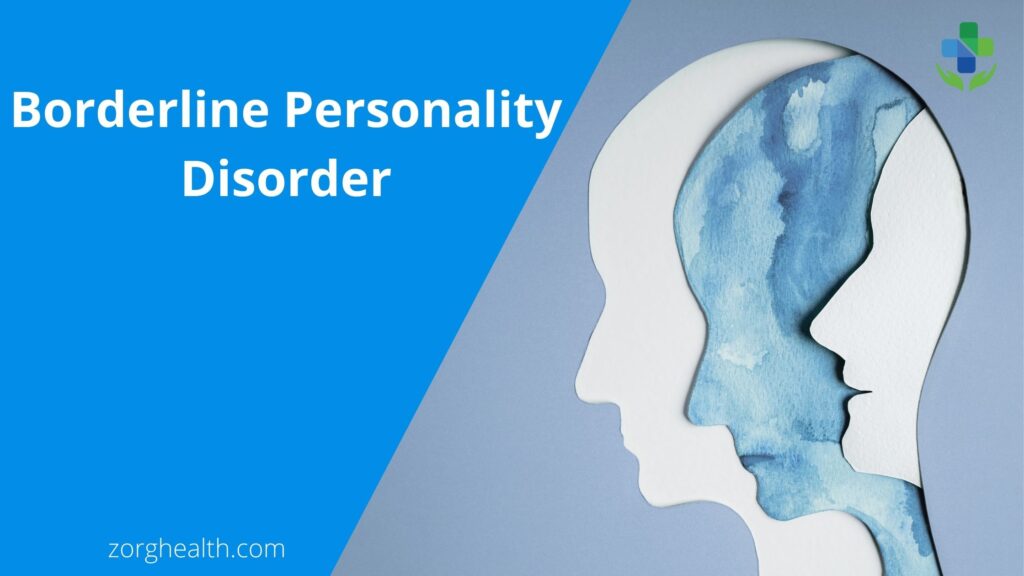Everyone experiences stress in different phases of their life, a healthy personality copes up with the challenges and move on, however, someone with a personality disorder finds it hard to live by. Borderline personality disorder (BPD) is a disorder of mental health which makes it difficult to be in touch with reality. Let’s understand what’s Borderline personality disorder by knowing the criteria for borderline personality disorder.

It is our personalities—how we behave, how we react, our worldview, thoughts, feelings, and how we interact in different associations—that make us different from the people around us. Our personalities are also shaped by our experiences, environment, and inherited traits. For someone with a personality disorder, different routine aspects of everyday life that many take for granted—can be a challenge—in terms of the long-term patterns of thought, feeling, and behavior.
What’s Borderline Personality Disorder (BPD)
Borderline personality disorder or BPD is a complex— incredibly distressful, serious mental health condition. It is a common personality disorder and sometimes known as an emotionally unstable personality disorder.
BPD primarily affects three key aspects of your life: How you feel about yourself, how you deal with other people and how you act— and are having problems in life as a result of this.
As per research, BPD usually starts in the late teens or early 20s and is generally found more women have it than men. When untreated, they can cause problems in the lives of people who have them and people associated with BPD.
Those with BPD may even be suffering from more than one related mental condition.
Symptoms that will decide the criteria for Borderline personality disorder
BPD symptoms tend to appear in early adulthood, peak in young adulthood, and improve with time. Very intense emotions can last from a few hours to even a few days and can change very quickly. Following are some of the key characteristics or symptoms of people with BPD:
Fear of abandonment
- Intense, often irrational fear of abandonment (imaginary or real separation or rejection).
- Desperate efforts to avoid being abandoned by friends or family.
- Extreme fear of neglect, uncaring, betrayed, deserted.
- Anxious particularly about how they are perceived.
- Come across as being clingy or needy.
- Constant push and pull of getting hurt.
Intense, unstable relationships
- Difficulty managing emotions
- The sudden shift from extremely loving to extreme hatred
- The pattern of unstable intense relationships
- Idealizing someone one moment and then suddenly believing the person is cruel/don’t care
- Cutting someone off completely
- Struggle to maintain healthy relationships
- Shift suddenly from closeness to anger
- Difficulty trusting others
- The feeling of not being good enough for partner
- Putting down on partner whether the partner did something wrong or failed to do something desired
- Need endless supply of reassurance
Difficulty controlling anger and outbursts
- Lashing out in anger
- Being sarcastic or bitter
- Physical fights
- Abusive
- Act erratically
- Poor anger management
- Difficult to return to a baseline emotion
Severe mood swings
- Extreme fluctuating mood
- Overly-sensitive
- Irritability
- Anxiety
- Intense happiness
- Shame
- Guilt
- Sadness
Negative self-image and self-esteem
- Loss of self-worth
- Unstable sense of self
- Sudden shifts in certain thought processes like values, career path, the importance of friends, or sexuality
- Rapid changes in self-identity
- Difficulty regulating emotions
- Self-critical
- Poor body image
Risky or impulsive behavior
- Drug abuse
- Unsafe sex
- Reckless spending
- Gambling spree
- Eating binges
- Risky driving
- Excessive alcohol or smoking
- Suddenly quitting a good job
- Suddenly ending a positive relationship
- Constantly changing goals
- Erratic life plans
Self-harming behaviors
- Recurring suicidal thoughts or actions
- Suicidal threats
- Self-injury
- Stress-related paranoid thoughts
- Perceive people and situations in extremes
- Manipulative (if you don’t give me all the attention I need, I’ll hurt myself)
Frequently feeling bored or empty
- Chronic feelings of emptiness
- Lack of direction
- Emotional stress
- Persistent need to have something to do
Feeling disconnected from thoughts or feelings
- Severe feelings of dissociation
- Splitting countertransference
- Feelings of detachment
- Loss of contact with reality
Some other characteristics of BPS include –
- Splitting behaviors – People with BPD often experience cyclical and sudden intense fears of abandonment and instability. To cope with these fears, they might use splitting as a defense mechanism to safeguard ego and prevent anxiety.
- Seeing life in black and white – Those with BPD tend to characterize themselves, others, situations, beliefs, objects in black and white or as either all good or all bad. Although they might know the world is complex and good and bad can exist together in one.
- Seeking validation – Those with BPD often seek validation outside to feel they are not as awful and to soothe insecurities. They have no emotional permanence and am unable to hold onto that validation when they get it.
Causes of Borderline personality disorder
There’s no certain cause of BPD. It’s believed to be a broad combination of the following factors that may cause BPD:
- Genetics (family history with BPD)
- Childhood trauma or abandonment
- Traumatic childhood experiences (abuse such as sexual, physical, emotional)
- Didn’t have consistent caregiving (neglect)
- Put in disturbing situations (overwhelming stress)
- Invalidating environment
- Life experiences (growing up surroundings/events)
- Post-traumatic stress disorder (PTSD)
- Brain abnormalities (or chemical imbalance or serotonin levels)
Traumatic Experience as a Child
The majority of the patients with BPD have a history of trauma of some sort —be it childhood trauma, sexual abuse, physical abuse, or emotional abuse at some point in their life.
Also, there may be a history where the child has lived in an “invalidating environment,” being told that your thoughts and feelings aren’t right or they don’t matter or they don’t count
Misconceptions for BPD
Here are some of the misconceptions about BPD.
- People with BPD don’t have multiple personalities. Bipolar disorder and BPD are two mental health conditions with some similar symptoms.
- If someone self-injures or feels emotional when left or abandoned, it doesn’t mean he or she has BPD.
- Just because someone is over sensitive doesn’t mean he or she is destined to develop BPD.
- Just as living can be manipulative or dangerous with someone, it doesn’t necessarily mean he or she has BPD.
- Anyone can be abusive, manipulative, or nasty—not just people with BPD.
Diagnosing or criteria for Borderline personality disorder
Any type of mental illness can be difficult to diagnose, as there is no specific medical or blood test available to screen for various mental disorders.
BPD is often misunderstood and very frequently misdiagnosed even by healthcare professionals as the symptoms of BPD overlaps or match with other personality disorders like bipolar, depression, or social phobia. That’s is why one must fit the patient for diagnosis only after knowing all the criteria for borderline personality disorder.
Just as some of the symptoms are similar, it doesn’t necessarily mean someone has BPD or any mental illness at all. Bipolar disorder and BPD are two mental health conditions—with distinctions between them.
BPD is tough to diagnose because its symptoms overlap with those of other mental health conditions. Individual cases can also vary greatly.
To get the most accurate diagnosis possible through various psychological evaluations, mental health professionals will need to rule out symptoms before being able to make a firm BPD diagnosis.
Treatment for Borderline personality disorder
BPD has been difficult to treat. However, there is no cure for BPD. New evidence-based treatments can manage the symptoms and improve the person’s quality of life.
Though sometimes medications claim to relieve symptoms, no medicine on its own is effective to treat BPD.
Long-term and regular psychotherapy is generally the main treatment for BPD. For example, treatment programs like Dialectical Behavioural Therapy (DBT) and Cognitive Behavioural Therapy (CBT), Schema-focused therapy (SFT), etc. Additional treatment options include other forms of group therapy, and visualization or meditation exercises.
Several types of therapy may benefit people with BPD, and each type takes a different approach.
How can you help people with Borderline personality disorder?
Inculcate healthy communication. Avoid saying things that can make the person with BPD feel slighted or uncared for.
Talk sensitive topics only when your partner is calm and not the times the BPD episode is going on when the person is more likely to be defensive, pull away, or turn to self-harming behaviors.
Offer understanding, emotional support, and encouragement to support their treatment. The partner needs to tell the person that they are there, that they understand it’s hard, and they want to help them in any way they can whether or not it’s rejected.
Avoid blaming or insulting everything the person with BPD says or does on their mental illness.
Take threats seriously regardless of whether you believe the BPD person plans to follow through. Self-harm or suicide as a form of blackmail should never happen in the relationship.
Prioritize self-care as being with a BPD person can feel exhausting and draining for both. Have an outside help or channel to deal with stress.
Believe that you can live a normal life with BPD. Assist in regular treatment and understanding for the BPD partner.
Ask open-ended questions to help them feel that they’re being heard.
Seek support from a mental health therapist as a couple as well to gain insight, communicate more effectively, resolve conflict, and strengthen their relationships.
Educate yourself about the disorder to understand that it’s an illness, not a choice, and increase empathy in a partnership.
The Bottom Line
Serious mental health disorders like BPD can wreak havoc on multiple facets of a person’s life.
People with BPD have chronic patterns of unstable thoughts making it difficult to regulate emotions and impulse control. The person with BPD might have conflicting interpersonal relationships— from work relationships to romantic ones. Sometimes having BPD is like walking on eggshells around yourself —which means it’s hard to know which way our mood is going to go, and it’s hard to control.
BPD can be a scary illness to live with, which is why it’s so important that people with BPD are surrounded by people who can understand and support them.
As the majority doesn’t know about the criteria for borderline personality disorder and due to an abundance of misconceptions around it, many people with BPD feel scared to speak out about living with it, even when many support options and treatments are easily available.
For people living with BPD and finding it difficult to cope, and especially thinking of self-harm or suicide, it is crucial to seek help.
Going down the road and going blow for blow isn’t going to get anyone anywhere.
